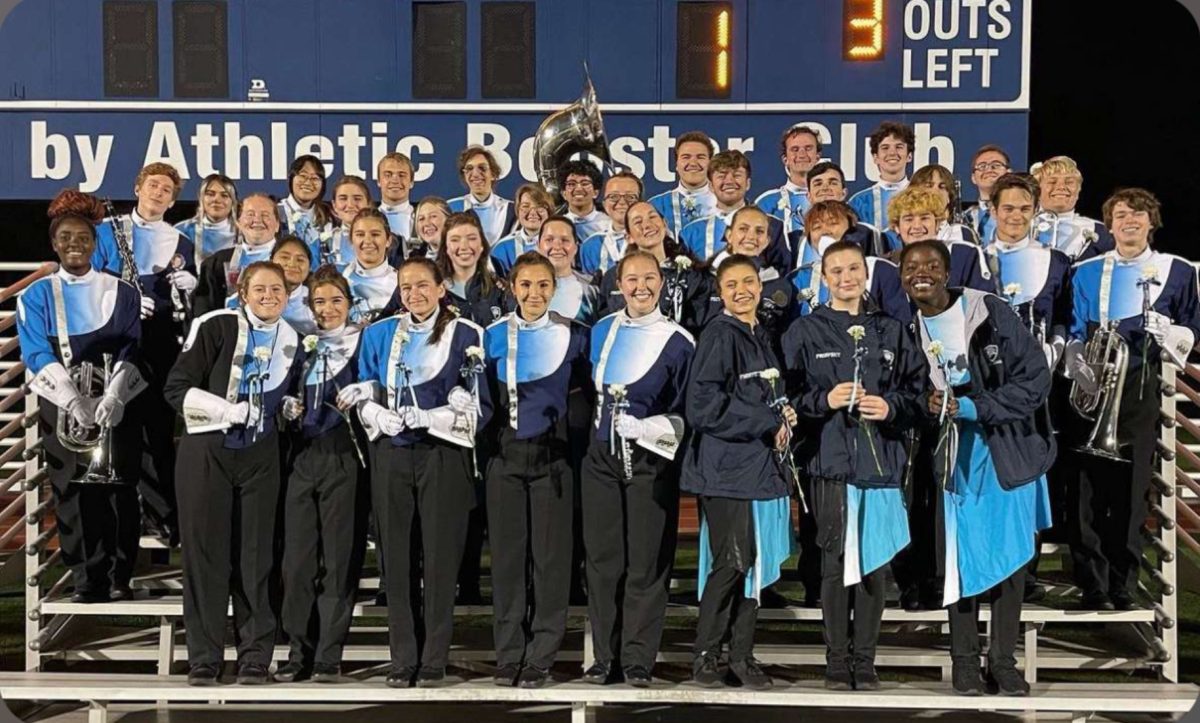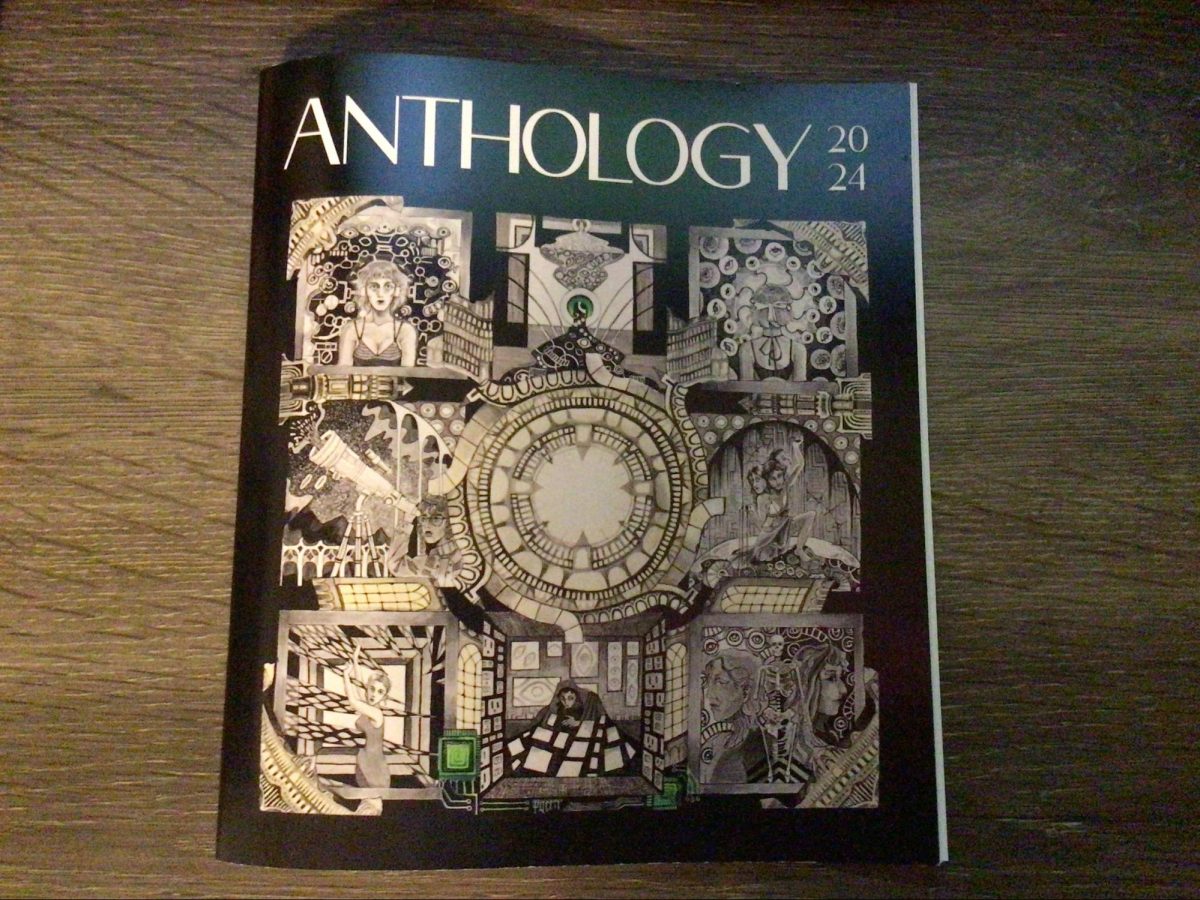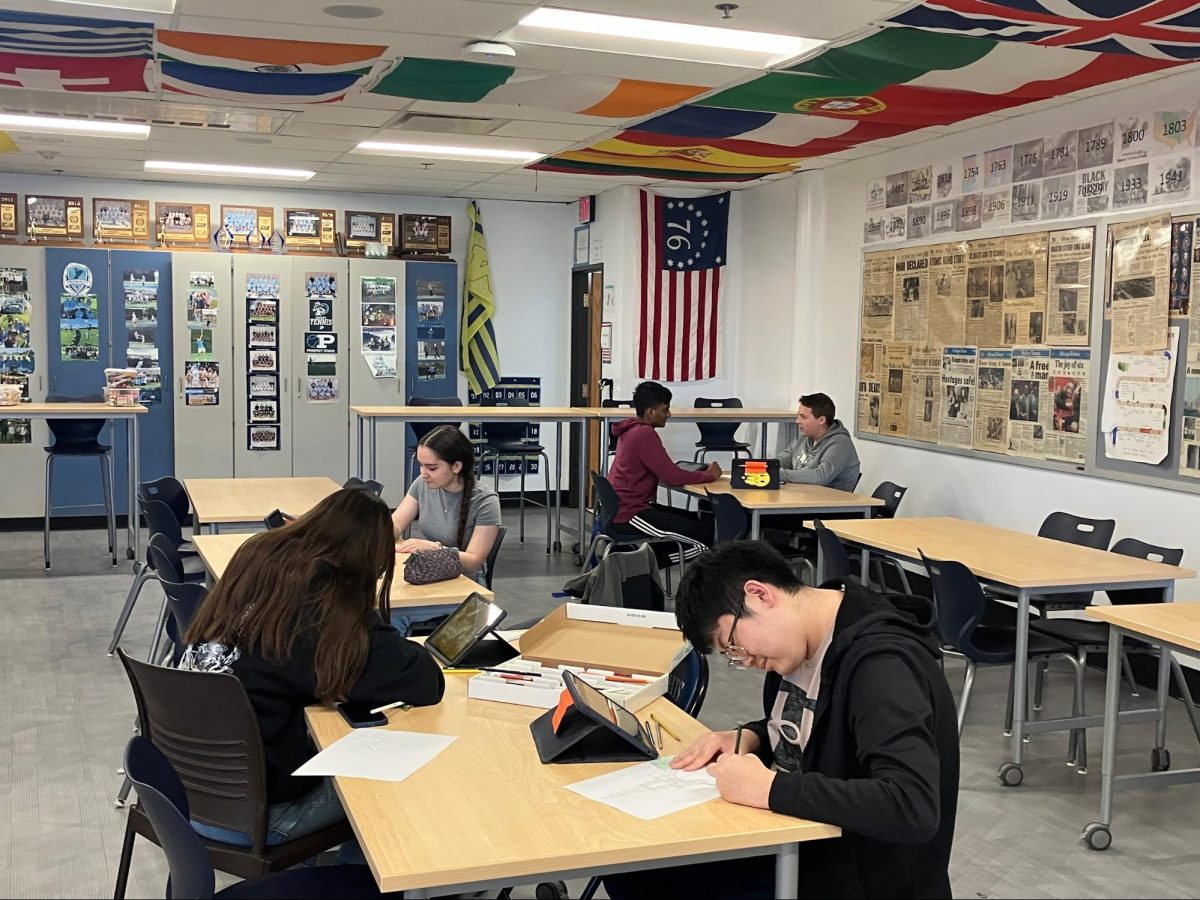According to the statistics, they should have lost. They played four elimination matches at the Midwest Regionals to reach the finals, and they were projected to lose every single one. Yet according to senior human player Ryan McCluskey, the high-level strategy and really-good defense played by WildStang, team 111, and their two alliance mates allowed the sixth-ranked alliance to advance to the final. This road to the final included a victory over two of the three highest-ranked teams in the regional competition.
“That was probably the biggest win because it was super exciting,” senior driver Alex Knipple said. “No one broke down, not even on their team, so it was just head-to-head, full, authentic [competition], and we were able to win. So that was a pretty good memory, because I remember it felt pretty good, and there was a lot of cheering, and it was a lot of fun.”
The WildStang Robotics Program consists of WildStang, team 111, and One, team 112. The teams are made up of students from all six schools in District 214, with WildStang being made of juniors and seniors, and One consisting of mostly freshmen and sophomores.
By making it to the finals of the Midwest regionals, WildStang earned a spot in the World Championships (commonly called Worlds), which took place in Houston from April 17 to April 20. The team left on April 16, and the competition began the next day.
In this year’s game, called Crescendo, the team had to create a robot that could pick up orange rings, called notes, and score them into a speaker or an amp. The speaker, which is about seven feet off the ground, is an angled rectangle that the robot shoots the notes into. The amp is a flat box that is closer to the ground, but the robot has to insert the note parallel to the ground, similar to a mail slot in a door. During tele-op, where Knipple is actively driving the robot, scoring a note into the amp is worth one point, while the speaker is worth two. However, scoring two notes in the amp allows the human player to amplify the speaker for 10 seconds, which causes all notes that enter the speaker to be worth five points. Notes shot into the speaker are also worth five points during autonomous when the robot drives by itself.
The first 15 seconds of the two-and-a-half-minute game are when the robots are autonomous, while the next two minutes are tele-op. The final 15 seconds are called endgame, and the robots attempt to climb onto the stage in the middle. The stage is made of three hanging chains arranged in a triangle, and the robots attempt to hang on the chains and place a note into an amp-like goal called a trap. However, the trap is four feet off the ground, which makes this year’s endgame very difficult. Teams can score five points for scoring a note into the trap and an additional three for being onstage. For teams that focus more on scoring points in the speaker and can’t climb the stage, such as WildStang, they can still score one point for being in the stage area when the game ends.
WildStang competed at two regional competitions this year, the Central Illinois Regional (CIR) and the Midwest Regional (Midwest). The format of both of these competitions was the same, with one day of practice matches and two days of actual competition. The first round of competitions are qualification matches, where each robot competes 10 times. The teams are randomly assigned alliances, so they are paired with different robots each time. During these matches, teams try to accrue ranking points, which are used to determine the final rankings of the teams after the qualification matches. Four ranking points are available to each alliance in each match: two points for winning, one point for scoring 18 notes into the speaker during the match, and one point for scoring 10 points on the stage.
After all the qualification matches are finished, the eight teams with the most ranking points become alliance captains for the elimination matches. These teams draft other teams to be in their alliance, working in a snake draft until there are three teams in each alliance. Teams can select any other team unless they are already in an alliance or have turned down an alliance offer. This can include the highest-ranked team selecting the second-highest-ranked team, which causes the ninth-highest-ranked team to move up and become an alliance captain.
Once the teams are picked, elimination rounds begin. The bracket is double elimination until the finals, where the winner of the loser’s bracket faces the undefeated winner of the main bracket. In this round, the competition is the best of three matches. The first alliance to win twice wins the regional. At both CIR and Midwest, WildStang’s alliance placed second.
This competition style is similar at Worlds, just with a lot more teams. There are approximately 600 teams that make it to Worlds, and they come from all parts of the country and the world. According to Knipple, some teams this year will hail from countries such as Turkey, France, Spain, Brazil and Japan.
The teams are randomly divided into eight divisions, each named after a famous scientist, and each of these divisions functions the same as regionals. The only difference is that four teams are selected per alliance, with one team being a backup in case something goes wrong with a starting team’s robot.
The winning alliance from each division then advances to the Einstein division, where the alliances go through another set of elimination matches. The fields here are Mass and Energy, and the winner from each field faces each other in the final.
“It’s quite a convoluted system, but it’s very cool to watch,” Knipple said.
While WildStang is one of the oldest First Robotics Competition (FRC) teams and has seen its fair share of challenging games, multiple students in the program agree that this year’s challenge is exceptionally difficult.
McCluskey noted the difficulty of shooting the notes with consistency and accuracy, as it is imperative to be quick when the speaker is amplified. Points scored during this time could mean the difference between winning and losing a match. A team with an inconsistent or inaccurate shot is not going to be able to score a lot of notes, which puts them at a great disadvantage.
In addition to the problems of the game, WildStang faced many challenges this year when working on their robot.
“What are some challenges?” McCluskey said when inquired about difficulties the team faced this year. “Oh, there were many.”
For starters, during the CIR regional, the feed system that moves the note to the robot’s shooter and stores it until it is ready to be shot was constantly failing. The note would sometimes get stuck in the robot, which prevented the team from picking up more notes and scoring points (holding multiple notes is a penalty). To make matters worse, the team couldn’t figure out what the problem was.
“We had no idea what’s wrong,” Knipple said. “We’re just…running around like…a chicken with a head cut off.”
They eventually found the problem and replaced the feed system, but another problem proved fatal in the final match at CIR: the vision system. The team relied on QR code-like implants on the field, called April Tags, to allow the robot to figure out its positioning on the field and about the speaker. However, their initial vision system, photon vision, wasn’t reading the Tags properly. Knipple believes this was due to the system not being impacted-rated, something that is important during an FRC competition.
“I don’t know if you’ve ever seen an FRC event, [but] it’s 150-pound robots going at 20 feet per second ramming into each other,” Knipple said. “So it’s pretty freaking violent.”
Despite this challenge, they were able to make it into the final, where another problem arose. One of the teams had added a plastic sheet with a smiley face on it to their robot for the final match, and their entire job was to place defense. This sheet blocked the April Tags on the field, which prevented the team from being able to reliably score.
“That was rough,” McCluskey said. “Having that stupid smiley face causing us not to be able to aim. I hated that smiley face.”
The team fixed these problems by switching to an impacted-rated vision system, called limelight, and adding limelight to acquire a bigger field of view. Despite this, the Midwest Regional revealed its own set of problems, especially involving the battery chargers.
The battery chargers had been overcharging the batteries, which led to lots of battery leaks throughout the season.
“I have cleaned up so many battery spills, I don’t even want to talk about it,” McCluskey said.
To make matters worse, even though the batteries were overcharged, they still weren’t charging properly. During the qualification matches at Midwest, WildStang had multiple brownouts, where the robot couldn’t last the entire match, so the team switched to a new battery charger, which solved these problems. There were also other mechanical and electrical issues throughout the competitions, but the team worked hard to solve those problems quickly.
The team’s perseverance through these challenges allowed them to qualify for Worlds in two separate ways. At the start of the season, WildStang had already technically made it to Worlds because they are a Hall of Fame team. All Hall of Fame teams get an automatic bid to Worlds, but seeing as this year’s team is completely different from the one that earned WildStang a spot in the Hall of Fame, Knipple, McCluskey, and the rest of the team wanted to earn their way there truly.
To earn their spot, they would have to win a regional or be close enough to win that they could earn a spot. At Midwest, they were the captain of the second-place alliance, which put them fourth on the list for earning a spot. Usually, only the two highest-placing teams would earn a bid (the alliance captain and their first selection), but both of those teams had already qualified for Worlds. The bid was then passed down the rankings, so WildStang had officially earned a spot in the World Championships. For Knipple, this was what he was hoping for at the start of the season.
“My goal was ‘get to worlds,’” Kinpple said. “That’s always my goal for every time we do it…getting to worlds is surprisingly difficult, especially in the Midwest.”
The team relied on last year’s experience at Worlds to help them this year. Knipple and McCluskey were both on the drive team last season as well, something that they believe will be beneficial in the heat of the moment.
“I think champs last year will be very helpful because it prepares you,” Knipple said. “It helps you expect the unexpected.”
Last year WildStang was placed in the Archimedes division, which was a very difficult division. WildStang was ranked seventh in the world last year, but the Archimedes division held eight of the top 10 teams in the world. Despite being a captain for the elimination matches and being one of the best teams in the world, WildStang was unable to win their division.
“Last year we kind of just got screwed, with all the really good teams being there,” Knipple said.
While Knipple was hopeful that this year’s division wouldn’t be as difficult, his wish didn’t come true. WildStang is in the Newton division this year, which is arguably as difficult as last year’s Archimedes division.
“This [year’s] division is bonkers hard,” McCluskey said. “It’s rough. Last year we were in the Archimedes division, which was like the hardest division ever, and people are calling this one Archimedes Part Two because it is kind of crazy.”
Regardless of the difficulties WildStang will face going up against some of the best teams in the world, Knipple and McCluskey have faith in their robot and teammates.
“I think if our robot performs the way that it can perform, we will have a very good chance of doing well in our division,” McCluskey said. “And if our strategy team performs and pulls out some bonkers strategy, then we have a very real chance of making it to [the] Einstein [field].”
They are confident in the abilities of the robot, mentors and fellow students, but they also know they will need some luck to make a deep run in the elimination matches.
“One of my mentors likes to say, ‘You have to have a really good robot and you have to be lucky to win champs,’” Knipple said. “We had a good robot last year, and we just weren’t lucky, so what are you going to do?”
Throughout the entire competition, Knipple and McCluskey look forward to competing with their robot, as well as meeting other teams from around the world and nation.
“Now that we’re at worlds, it’s like the elite level,” McCluskey said. “You’re going to see all the elite-level teams who are doing it well.”
Especially since it’s their senior year, the two drive team members are looking forward to enjoying the atmosphere of Worlds and spending their final competition with their teammates.
“It’s such a cool experience,” Knipple said. “Very few people get to experience something this awesome, so I want to make sure to enjoy it since it’s my last time.”








